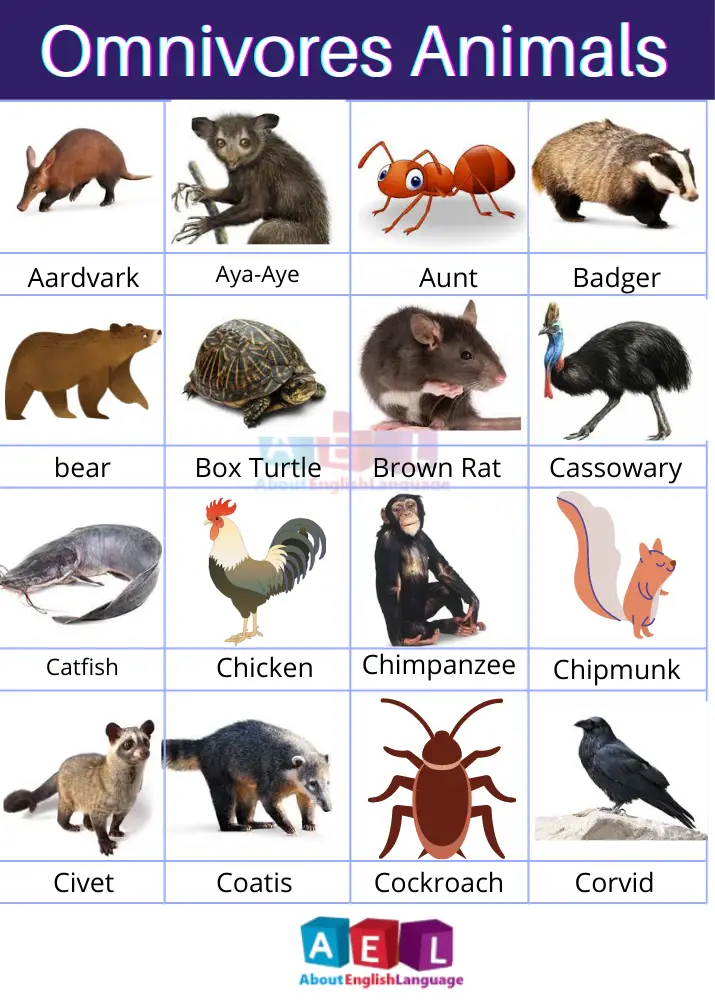Here in this topic, Omnivores Animals Names List we discuss all the animals that are under the category of omnivore animals with a complete list and beautiful pictures of these animals.
Omnivores Animals:
There are some animals in nature that have diets that consist of both meat and plants and are therefore considered omnivores.

The word omnivore comes from the Latin Omni and Voro, which translates to eater of all things. It was first used in scientific circles in 1806 to describe humans and bears but has since grown to include birds, reptiles, and fish among other species that eat both plants and meat. And yes, humans are omnivores too.
Omnivores are animals that eat both plants and other animals, which makes them different from carnivores, herbivores, and many other animals that mostly eat one or the other.
Omnivores can be predators or scavengers, depending on what’s available to them in their environment.
Some examples of omnivores animals include;
Humans
Bears
Raccoons
List of Omnivores Animals Name:
- Aardvark
- American Black Bear
- American Hog-Nosed Skunk
- Ant
- Aya-Aye
- Badger
- Bearded Dragon
- Bear
- Black-Backed Jackal
- Bonnethead Shark
- Box Turtle
- Brown Rat
- Cassowary
- Catfish
- Chicken
- Chimpanzee
- Chipmunk
- Civet
- Coatis
- Cockroach
- Common Snapping Turtle
- Corvid
- Coyote
- Crane
- Cricket
- De-Braza’s Monkey
- Dog
- Duck
- Earthworm
- Earwig
- Eastern Fox Squirrel
- Emu
- Fennec Fox
- Fish
- Flamingo
- Flies
- Galago
- Gibbon
- Great Ape
- Grizzly Bear
- Groundhog
- Hedgehog
- Human Being
- Hummingbird
- Kea
- Long-Nosed Bandicoot
- Mouse
- Monkey
- Olive Baboon
- Opossum
- Oriole
- Ostrich
- Pygmy Grasshopper
- Raccoon
- Rallidae
- Rat
- Red-Rumped Agouti
- Rhea
- Rhino
- Robin
- Rook
- Rudderfish
- Seagull
- Skunk
- Sloth
- Spider Beetle
- Spider Monkey
- Squirrel
- Starling
- Sugar Glider
- Swan
- Tapanuli Orangutan
- Warthog
- Wasp
- Western Gorilla
- White-footed Mouse
- White-Fronted Chupchin Monkey
- Wild Boar
- Woodpecker
Omnivores Animals Name with Pictures:
Squirrel:
According to the National Wildlife Federation, there are many different types of squirrels in North America. Some are herbivores and live on nuts, seeds, and grasses, while others are omnivores that eat plants as well as insects, grubs, and carrion (dead animal flesh).
All squirrels have an instinctual ability to remember where they have buried their food sources—a trait that enables them to store up food when it’s plentiful so they can access it during lean times.
These small creatures will eat almost anything, including insects, seeds, fungi, eggs, and even small mammals and birds! Squirrels have an interesting way of getting food from some of the nastiest places—including other animals’ nests and carcasses.
Their eating habits have earned them the nickname nature’s plumbers because they keep many ecosystems healthy by disposing of dead animals and plants that could otherwise attract predators or rot and spread disease.
Ostrich:
Ostrich is actually an omnivore, meaning it can eat both plants and animals. Though it mostly eats meat, the ostrich also consumes large amounts of plants at certain times of the year.
When it comes to its nutritional needs, the ostrich doesn’t discriminate; it’s one of nature’s ultimate omnivores.
The ostrich is such an interesting animal, and it’s one of my favorites because it just so happens to be an omnivore! It eats both plants and animals.
It’s true that they have been seen eating meat—some that they’ve killed themselves—and have been spotted eating vegetable matter like grasses and roots too.
But the reason they are an excellent example of an omnivore isn’t that they eat both animal products and plant products, but rather because they eat almost anything within reach, regardless of whether it’s an animal or a plant.
Rhino:
Rhinos are one of the largest mammals on earth, capable of reaching weights of up to 4000 pounds and lengths of 12 feet.
Rhinos will eat pretty much anything in their path! Scientists believe that their omnivorous diet is due to their unique digestive system.
Chimpanzee:
The chimpanzee has a lot in common with humans, but they are not in the same family as us. In fact, they are closer to gorillas than they are to us, which means they’re also classified as being omnivores just like us.
A lot of people think the chimpanzee is exclusively an herbivore, but this isn’t true at all! Chimpanzees do eat meat; they just don’t go out and hunt it as we do. Instead, they scavenge or steal their food.
This can result in the consumption of large amounts of protein and fat, which may seem contradictory to their generally herbivorous diet.
Catfish:
Catfish have the reputation of being carnivores, but they are actually omnivores. This means that they eat meat and plant matter; they are not exclusively meat-eaters.
Although catfish mainly eat fish, they also consume insects, plankton, algae and small invertebrates in the wild. You may have seen YouTube videos of people feeding live fish to their pet catfish.
Because catfish eat both plants and animals, it’s important to know what kind of environment you need to create in order to keep them healthy and happy in captivity.
Duck:
Most people know that ducks are omnivores, but not many people know why ducks eat both plants and animals. It’s not because they aren’t smart enough to distinguish between plants and animals as food sources; it’s just what ducks do. Ducks are notorious plant-eaters and insect-eaters, More omnivorous animals
